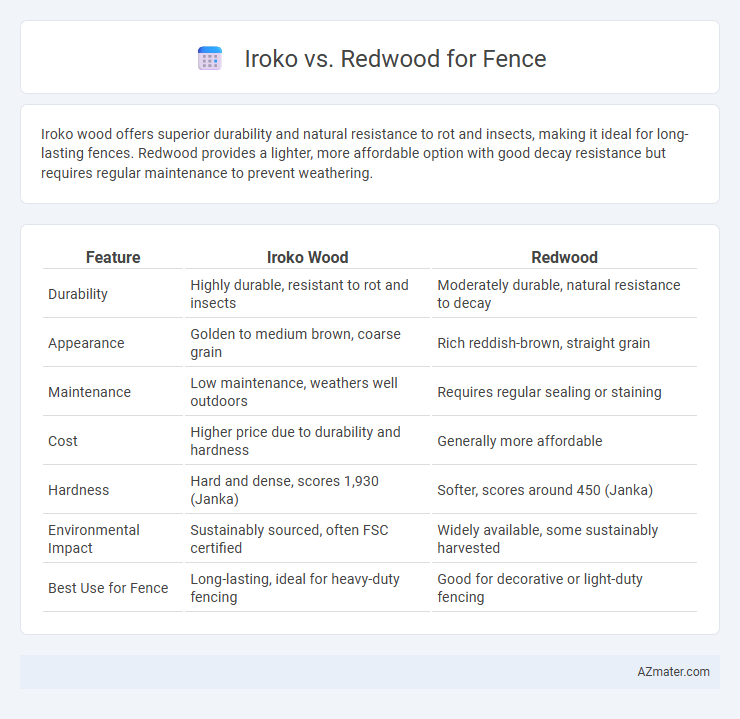Iroko wood offers superior durability and natural resistance to rot and insects, making it ideal for long-lasting fences. Redwood provides a lighter, more affordable option with good decay resistance but requires regular maintenance to prevent weathering.
Table of Comparison
| Feature | Iroko Wood | Redwood |
|---|---|---|
| Durability | Highly durable, resistant to rot and insects | Moderately durable, natural resistance to decay |
| Appearance | Golden to medium brown, coarse grain | Rich reddish-brown, straight grain |
| Maintenance | Low maintenance, weathers well outdoors | Requires regular sealing or staining |
| Cost | Higher price due to durability and hardness | Generally more affordable |
| Hardness | Hard and dense, scores 1,930 (Janka) | Softer, scores around 450 (Janka) |
| Environmental Impact | Sustainably sourced, often FSC certified | Widely available, some sustainably harvested |
| Best Use for Fence | Long-lasting, ideal for heavy-duty fencing | Good for decorative or light-duty fencing |
Introduction to Iroko and Redwood for Fencing
Iroko is a dense, durable hardwood native to West Africa, known for its natural resistance to rot, termites, and weather, making it an excellent choice for long-lasting fencing. Redwood, primarily sourced from the western United States, features a rich, reddish hue and contains natural tannins that protect against decay and insect damage, offering both beauty and resilience. Both timbers provide robust options for fencing, with Iroko often favored for its strength and Redwood prized for its aesthetic appeal.
Key Characteristics of Iroko Wood
Iroko wood, often called African teak, is prized for its high density, natural resistance to decay, and rich golden to medium brown color that deepens over time, making it an excellent choice for fencing. It offers superior durability comparable to redwood, with exceptional resistance to insects and moisture, ensuring longevity in outdoor applications. Iroko's coarse grain and oily texture provide stability and low maintenance, distinguishing it as a premium hardwood option for fence construction.
Key Characteristics of Redwood
Redwood fences are known for their natural resistance to decay, moisture, and insect damage, making them a durable choice for outdoor use. The wood features a rich reddish hue and fine grain, which enhances its visual appeal without extensive finishing. Redwood is lightweight compared to dense hardwoods like Iroko, offering easier handling and installation while maintaining strong structural integrity.
Durability Comparison: Iroko vs Redwood
Iroko and Redwood are popular choices for fencing due to their durability, with Iroko offering superior resistance to rot, insects, and harsh weather conditions, often lasting up to 50 years with minimal maintenance. Redwood provides natural decay resistance and stability but typically requires regular sealing and treatment to maintain durability, lasting around 20 to 30 years. Both woods perform well outdoors, but Iroko's dense grain structure and natural oils provide a longer lifespan and greater resilience against environmental damage.
Weather Resistance and Longevity
Iroko wood offers exceptional weather resistance due to its natural oils and dense grain, making it highly durable against moisture, rot, and insects, with a lifespan of 25 to 40 years in outdoor fencing applications. Redwood is also weather-resistant, especially its heartwood, which contains tannins that protect it from decay and insect damage, generally lasting 20 to 30 years when properly maintained. While both woods are strong contenders for outdoor fencing, Iroko's superior natural oils give it a slight edge in longevity and resistance to harsh weather conditions compared to Redwood.
Appearance and Aesthetic Differences
Iroko wood boasts a rich golden to yellow-brown hue that deepens with age, displaying a coarse, interlocked grain which gives fences a warm, textured appearance ideal for traditional or rustic settings. Redwood features a natural reddish tone with a fine, straight grain that exudes elegance and smoothness, making it popular for sleek, modern fence designs. The distinct color variations and grain patterns between Iroko and Redwood provide fence owners with clear aesthetic choices depending on desired visual impact and architectural style.
Maintenance Requirements for Each Wood Type
Iroko wood requires minimal maintenance due to its natural oil content, which provides resistance to rot, insects, and weathering, making it ideal for long-lasting fencing with occasional cleaning and oiling. Redwood fencing demands more regular upkeep, including sealing and staining every few years to prevent moisture damage, decay, and pest infestation, as it is softer and less dense than Iroko. Both woods benefit from proper installation and ventilation, but Iroko is generally preferred for low-maintenance outdoor fencing projects.
Environmental Impact and Sustainability
Iroko and Redwood differ significantly in environmental impact and sustainability, with Redwood often being favored due to its natural resistance to decay, allowing for longer lifespan without chemical treatments. Iroko, a tropical hardwood, raises concerns over deforestation and habitat disruption when harvested unsustainably, whereas Redwood is typically sourced from well-managed forests with certifications like FSC. Choosing Redwood supports sustainable forestry practices and reduces carbon footprint compared to Iroko, which involves greater ecological risks from tropical logging.
Cost Analysis: Iroko vs Redwood
Iroko wood typically costs more upfront than redwood due to its density and durability, ranging from $25 to $35 per linear foot compared to redwood's $15 to $25. Redwood offers a more budget-friendly option but may require more frequent maintenance and replacement, increasing long-term expenses. When analyzing total cost of ownership, Iroko's resistance to rot and insects can lead to lower maintenance costs, potentially offsetting the higher initial investment.
Which Wood is Best for Your Fence?
Iroko offers exceptional durability and natural resistance to decay, making it ideal for long-lasting fences in humid or wet climates. Redwood features a rich color and natural tannins that resist insects and rot, creating a visually appealing and low-maintenance fencing option. Choosing between Iroko and Redwood depends on your priority: Iroko excels in strength and weather resistance, while Redwood is preferred for aesthetic warmth and ease of upkeep.

Infographic: Iroko vs Redwood for Fence
 azmater.com
azmater.com